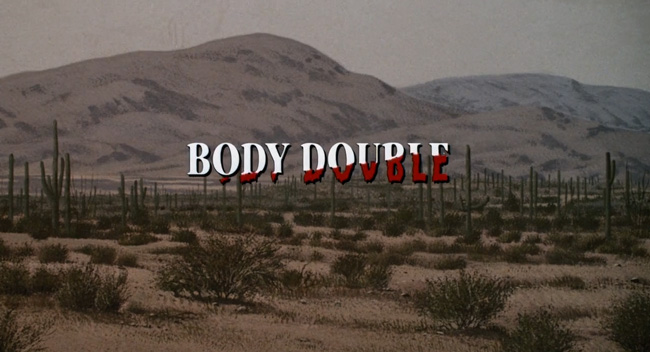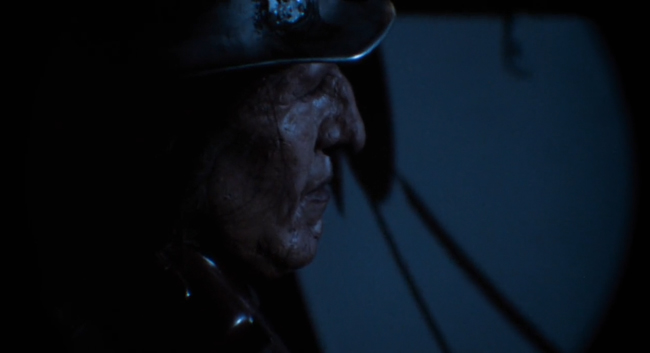Body Double
Written by Robert J. Avrech and Brian De Palma
Directed by Brian De Palma
USA, 1984
It is obvious that Body Double (1984) is a combination of the plots of Vertigo (1958), Rear Window(1954) and Dial M for Murder (1955) by Alfred Hitchcock, and nearly as obvious to say that the film also takes cues from Michael Powell’s Peeping Tom (1960) and elements from various slasher films like Abel Ferrara’s The Driller Killer (1979). Unfortunately, a good number of critical pieces on Brian De Palma are obsessed with listing off his influences and coming to the inept conclusion that he is merely a Hitchcock imitator with a couple of clever cinematic tricks up his sleeve. Few writers take De Palma on his own terms, though select critics are finally coming around, and most ignore the way he constructs his complex thriller narratives, creates exquisite images that take advantage of cinema’s unique artistic properties, and underscores his films with dissenting politics. Body Double features all of these elements and more, making this film one of De Palma’s finest and most entertaining in his extensive filmography.
The protagonist of Body Double is played by Craig Wasson, a D-list actor playing a D-list actor named Jake Scully that suffers from claustrophobia. The film opens on the set of a low-budget horror movie called “Vampire’s Kiss” and Jake is having a panic attack during the middle of a take. The director calls cut and gives Jake the day off to recoup. Jake decides to surprise his girlfriend at home but walks in on her fornicating with another man. These events kick starts De Palma’s perfect thriller about voyeurism and trash culture.
Like so many of De Palma’s films, Body Double is not simply a well-constructed thriller alone, but also a sardonic look at pop culture. Body Double is simultaneously an exploration, exaltation and condemnation of trash culture, embodied in the film as low-budget horror movies and soft-core pornography. De Palma originally wanted to cast Annette Haven in the lead female role because he believed Haven was a terrific performer and had a terrific body, but eventually decided on Melanie Griffith. Pop culture is treated like in Jean Luc-Godard’s Week End (1967), an anarchic, important sixties film that satirizes everything and anything in late-capitalist culture. Body Double is less disdainful towards pop culture than Weekend because De Palma appears to have an uncanny attitude toward the culture he is depicting.
Up to this point in De Palma’s career, critics pigeonholed him as a trashy filmmaker that reveled in misogyny and graphic violence. Rather than retreating, De Palma took his cinema to the extreme in Body Double. His films repeatedly blur the line between high and low art (or however that is understood when thinking about high and low culture within the medium of cinema). Consider the opening credits of the film which essentially have two fonts: the first font is a dark red one that resembles vampire B-movies, which slowly drips away to reveal the sharp white, prestigious font underneath. De Palma’s best films tend to obliterate the boundaries between high and low art, often leaving viewers and critics unsure of how to interpret his images and his intentions behind them.
The setting for Body Double uses the milieu of the soft-core porn and the low-budget movie industry in Los Angeles as a backdrop. Not only does De Palma revel in the low-brow art of Los Angeles, but he also shoots stylish modernist architecture in the film, along with sunny Californian streets, beaches full of lazy people sun-tanning during a chase sequence, images that feature elaborate outdoor shopping centers and expensive beach side houses, ambivalent joggers listening to their portable cassette players, and lots of shiny convertible cars like the one Jake drives around in throughout the film. The modernist loft where Jake sublets, while his new friend Sam Bouchardwork is in Seattle, is a posh, sexy pad that Jake and Sam gush over, laughing like morons as they drink from the owner’s bar, marveling at the spinning bed and beautiful view. The chance to stay at this beautiful apartment appears to ameliorate Jake’s woes concerning his job and ex-girlfriend.
The real pleasure of this film is the way De Palma shoots and cuts the voyeurism scenes. De Palma exhibits an expert use of camera compositions and cutting between Jake’s point of view looking through the telescope and panning to the “Indian” voyeur. There are two voyeurs in this sequence: the audience is identifying with Jake but is confronted with another voyeur. The first voyeur, Jake (standing in as the audience, the voyeur of every film), is there to condemn the second voyeur. But, what is the difference between them? Both voyeurs are enjoying Gloria’s striptease spectacle and yet one is the hero and one is the villain, but both are guilty of peeping.
De Palma foreshadows this weird voyeur moment in an earlier scene of the film where Jake discovers his girlfriend is cheating on him. While Jake walks through the house, De Palma films the activity like a stalking sequence from a slasher film. We see photographs of Jake with his girlfriend and we hear her laugh in one of the rooms down the hall. Jake plans to surprise her, thinking she might be in the middle of a shower or an auto-erotic session, smiling like a horny teenage boy anticipating spotting a topless neighbor. His attempt at voyeurism is immediately spoiled when he discovers that his longtime girlfriend is having sex with another man, and enjoying it quite a bit. Jake’s reaction to this discovery is priceless: he looks hurt, confused and angry, while at the same time making eye contact with his girlfriend. His intrusion does not stop her from enjoying herself and she quickly looks down at her lover while Jake slinks out of the room, a deflated and defeated man. Jake’s early punishment is then carried over to the first voyeuristic sequence involving Gloria. Jake is able to take pleasure in this voyeurism until he discovers another voyeur that is grotesque, threatening his sexual fantasy. This threat to his fantasy motivates Jake to protect Gloria.
In Body Double, Jake is repeatedly mistaken as the bad guy. For example, he is attacked by Gloria’s white dog when he attempts to save her, he is questioned by a security guard in the outdoor shopping mall, and then receives the same treatment from an investigating officer ( “You’re a peeper. In my book that’s a pervert”). Jake is not only in love with a body double but he also has one of his own. Not one that stands in for him, but a body that he chases around Los Angeles while stalking Gloria. When Jake follows Gloria to the outside mall, the clerk in the panty store calls security on Jake, but the same clerk fails to see the grotesque figure stalking Gloria.
Eventually, we discover that the body Jake lusts over is a body double: not the real Gloria, but a porn actress hired by a mysterious man to put on a striptease for Jake every night. Jake only discovers this later on, so in the first section of the film he follows what he believes to be his fantasy object. Still a voyeur, Jake spies on Gloria from a distance, setting himself up as her hero, another fantasy Jake takes part in but does not have the strength or potency to fulfil in reality. When they kiss after Glora’s purse is stolen, De Palma changes the image so that it glows, and spins his camera around the couple; the piano score swells, and the couple looks like they are standing against a rear projection of the beach setting. The image bursts with melodramatic romance film codes that make it appear almost like a daydream, one that has escaped from Jake’s unconscious onto the screen.
When Jake discovers that he has been peeping on Holly Body (Griffith) and not Gloria, he decides to track her down to figure out who hired her to dance for him. Their first meeting, on a porn shoot, is the fulfillment of the sexual fantasy that Jake created when stalking/protecting Gloria. Like all pornography, we get to goods right away: there is no seduction, no games, just sex. There are no closed spaces, so Jake can perform as good as any stud in the scene and he gets the job done.
At the beginning of the film, Jake is fired from the low-budget vampire movie and visits the set to confront the director after his agent shares the news. He sees his replacement groping a woman in a shower scene, which becomes another instance where Jake has been sexually rejected because that could have been him enjoying the perks of his role as a vampire in the movie. This rejection is paid off at the end of the film once Jake has defeated his claustrophobia. Rarely do thrillers connect everything in the film, and De Palma finds a way to intricately join everything introduced in the first half of the film with the resolutions at the end. The film concludes with Jake back in the lead of “Vampire’s Kiss”, happily groping the body double’s breast in the shower.
— Cody Lang









